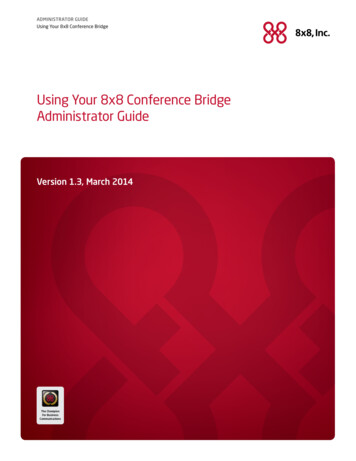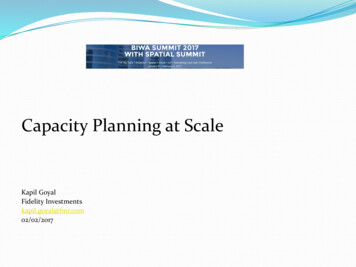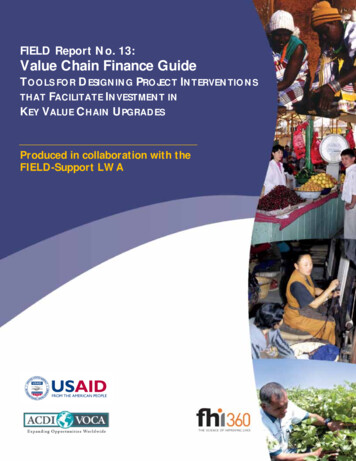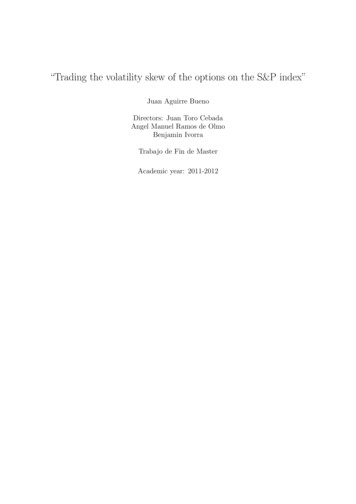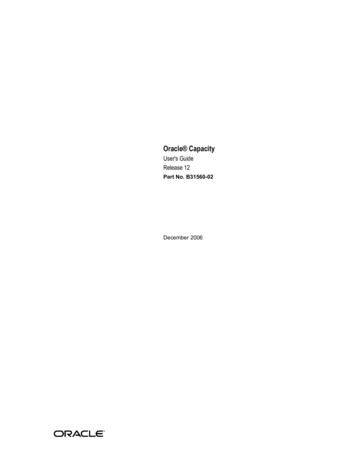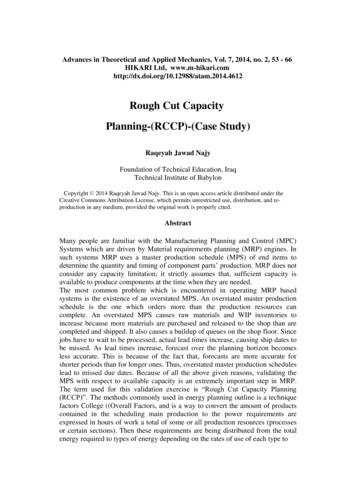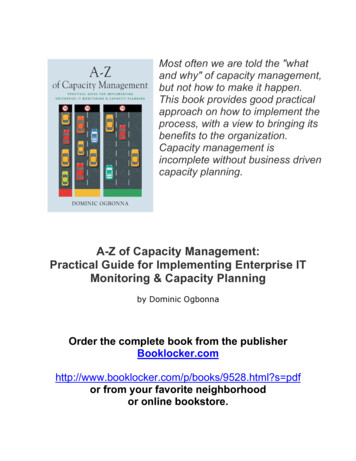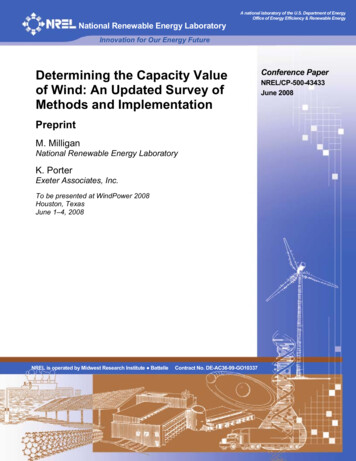
Transcription
A national laboratory of the U.S. Department of EnergyOffice of Energy Efficiency & Renewable EnergyNational Renewable Energy LaboratoryInnovation for Our Energy FutureDetermining the Capacity Valueof Wind: An Updated Survey ofMethods and ImplementationPreprintM. MilliganNational Renewable Energy LaboratoryK. PorterExeter Associates, Inc.To be presented at WindPower 2008Houston, TexasJune 1–4, 2008NREL is operated by Midwest Research Institute BattelleContract No. DE-AC36-99-GO10337Conference PaperNREL/CP-500-43433June 2008
NOTICEThe submitted manuscript has been offered by an employee of the Midwest Research Institute (MRI), acontractor of the US Government under Contract No. DE-AC36-99GO10337. Accordingly, the USGovernment and MRI retain a nonexclusive royalty-free license to publish or reproduce the published form ofthis contribution, or allow others to do so, for US Government purposes.This report was prepared as an account of work sponsored by an agency of the United States government.Neither the United States government nor any agency thereof, nor any of their employees, makes anywarranty, express or implied, or assumes any legal liability or responsibility for the accuracy, completeness, orusefulness of any information, apparatus, product, or process disclosed, or represents that its use would notinfringe privately owned rights. Reference herein to any specific commercial product, process, or service bytrade name, trademark, manufacturer, or otherwise does not necessarily constitute or imply its endorsement,recommendation, or favoring by the United States government or any agency thereof. The views andopinions of authors expressed herein do not necessarily state or reflect those of the United Statesgovernment or any agency thereof.Available electronically at http://www.osti.gov/bridgeAvailable for a processing fee to U.S. Department of Energyand its contractors, in paper, from:U.S. Department of EnergyOffice of Scientific and Technical InformationP.O. Box 62Oak Ridge, TN 37831-0062phone: 865.576.8401fax: 865.576.5728email: mailto:reports@adonis.osti.govAvailable for sale to the public, in paper, from:U.S. Department of CommerceNational Technical Information Service5285 Port Royal RoadSpringfield, VA 22161phone: 800.553.6847fax: 703.605.6900email: orders@ntis.fedworld.govonline ordering: http://www.ntis.gov/ordering.htmPrinted on paper containing at least 50% wastepaper, including 20% postconsumer waste
Determining the Capacity Value of Wind:An Updated Survey of Methods andImplementationMichael MilliganNational Renewable Energy Laboratory1617 Cole Blvd.Golden, CO 80401303-384-6927303-384-6901 (fax)michael milligan@nrel.govwww.nrel.gov/windKevin PorterSenior AnalystExeter Associates, Inc.5565 Sterrett PlaceSuite 310Columbia, Maryland 21044410-992-7500410-992-3445 .comAbstractElectric systems must have sufficient reserves so that resources are adequate to meet customerdemand. Because electricity demand cannot be known in advance with certainty, and becausegeneration can experience mechanical or electrical failures which take it out of service (i.e.,experience forced outages), a planning reserve that consists of installed capacity in excess ofload requirements is necessary to maintain reliability. This reserve is applied in the planning timeframe (i.e., one year or more), and is a determination of system adequacy: is there sufficientinstalled generation to meet load obligations? Capacity requirements are currently implementeddifferently from region to region, but a new Resource Adequacy Assessment standard is underdevelopment by the North American Electric Reliability Corporation (NERC) which wouldestablish consistent requirements for NERC regions to assess adequacy. As wind achievesgreater penetration in the United States, it will become important to address the issue of howwind contributes to system adequacy. Wind’s contribution to adequacy is its capacity value.1
The level of wind capacity value is a matter of debate in some regions, due to the variability ofwind power and its relationship with load. Utilities and other entities typically allocate somecapacity value to wind power, although at a lower level than other energy technologies. All ofthe nation’s regional transmission organizations (RTOs) assign a capacity value to wind, andsome states, as well as studies in Colorado and Minnesota, have also determined that windenergy has a capacity value.This paper examines the various methods used to estimate the capacity value of wind and is anupdate of a paper we presented at WINDPOWER 2005. This paper summarizes severalimportant state and regional studies that examine the capacity value of wind energy, howdifferent regions define and implement capacity reserve requirements across the country, andhow wind energy is defined as a capacity resource in those regions. Updates on changes to thecapacity value of wind in ERCOT, ISO New England, PJM, California, and New York will beprovided. We also provide an overview of wind capacity value in Europe.Introduction and OverviewWith over 18 GW of installed wind capacity in the United States as of first quarter 2008, andanother 4 GW under construction, the question of wind’s capacity value (sometimes calledcapacity credit) is gaining more attention. 1 Wind’s low cost and environmental benefits, and thehigher cost of competing fuels such as natural gas, mean that system planners will need tograpple with how to determine the capacity value of wind energy. It does seem clear that wind’sprimary value is as an energy resource, but to the extent to which it contributes towards systemadequacy is an important question.Effective load carrying capability (ELCC) is an often-used metric to assess capacity credit, notonly for wind plants, but for any power plant. A typical power plant has a relatively low forcedoutage rate, which implies a high availability rate. This translates into an ELCC value that istypically a large percentage of the conventional plant rated capacity. In fact, the ELCC can oftenbe approximated by the unforced capacity C(1-r) where C capacity and r forced outage rate.Wind generators typically have very high mechanical availability, exceeding 95% in manyinstances; i.e., the forced outage rate is often below 5%. However, because wind generators onlygenerate electricity when the wind is blowing, wind’s availability rate (the rate that power andenergy can actually be provided) is a function of the wind speed throughout the year. Therefore,the effective forced outage rate for wind generators may be much higher, from 50% to 80%,when recognizing the variable availability of wind. In addition, wind’s value to the electricsystem may also vary. The output from some wind generators may have a high correlation withload and thereby can be seen as supplying capacity when it is most needed. In this situation, awind generating plant should have a relatively high capacity credit. The output from other windgenerating plants may not be as highly correlated with system load, and therefore would have a1American Wind Energy Association. “With Uncertainty Looming Over Federal Incentive, U.S. Wind IndustryInstalls 1,400 MW in First Quarter.” May 7, 2008.http://www.awea.org/newsroom/releases/AWEA Market Release Q108.html.2
lower value to the electric system and should receive a lower capacity credit 2 . The correlation ofwind generation with system load, along with the wind generator’s outage rate, is the primarydeterminants of wind capacity credit. There are other lesser influences that are described later inthis paper.Emerging Resource Adequacy StandardsThis paper describes current approaches and processes used in North America and other parts ofthe world for determining the capacity value of wind. As capacity value is a component used indetermining resource adequacy, the ongoing effort by NERC to develop standards is animportant related event. As mandated by the Energy Policy Act of 2005, reliability organizationsare to ”conduct periodic assessments of the reliability and adequacy of the bulk power system ofNorth America.” 3This future standard or standards, when approved, would establish requirements for each of theeight Regional Reliability Organizations to create a metric or metrics and to assess resourceadequacy for its region. The Resource Adequacy SAR (Standard Authorization Request)drafting team has completed its SAR Form 4 and NERC has assigned this to a group of projects tobe completed in 2009.To address resource adequacy and other issues related to variable generation such as wind andsolar technologies, NERC has created a work group called the Integration of Variable GenerationTask Force (IVGTF) to develop a white paper to describe planning and operational issues,review NERC standards for any gaps, and provide conclusions and recommendations. Thefuture results of the IVGTF efforts could provide more detailed guidance on the issue of capacityvalue and on standards that may be needed.System Resource AdequacyPower system resource adequacy is typically measured by conducting a comparison of installedcapacity and peak loads over some time horizon. Because all generators have a non-zeroprobability of failure, and because loads cannot be known with certainty in advance, the systemmust have a planning reserve margin. The planning reserve margin is a level of installed capacitythat exceeds expected peak demand, and is typically analyzed one or more years in advance. Oneoften-used approach is to use a fixed level of planning reserve, such as 15%, and determinewhether the installed generation fleet capacity is 15% higher than expected load. If the installedcapacity meets the planning reserve criterion, the system is considered adequate. However, thisapproach does not take account of the role of generators’ forced outage rates on adequacy, nordoes it quantify the percentage of time that the system may be inadequate.2Milligan, M. and B. Parsons (1999), “A Comparison and Case Study of Capacity Credit Algorithms for WindPower Plants. Journal of Wind Engineering. Multi-Science Publishing Co. LTD. Brentwood, Essex, UnitedKingdom. Vol 23, No. 3, 1999.3Energy Policy Act Of 2005, Title XII-electricity, Subtitle A-Reliability Standards, (g) RELIABILITY REPORTS4http://www.nerc.com/ filez/standards/Resource Adequacy.html3
A more rigorous approach to assess system adequacy is based on power system reliability theory.Using a model of the hourly loads, generation capacity, and forced outage rates, loss of loadprobability (LOLP) or a similar reliability metric can be calculated for the system. Since LOLP isa probability that is typically calculated for each hour, it is desirable to convert this to an annualmeasure of system adequacy. This is often done by calculating the product of probabilities andhours, resulting in loss of load expectation (LOLE). LOLE is measured in units such ashours/year, days/year, or days/10 years, and provides a measure of how adequate the system is.With modern interconnected power systems, the LOLP does not necessarily measure theprobability that load will be shed because of insufficient generation. The LOLP metric measuresthe risk that generation cannot meet the peak demand unless capacity is imported. Whenperforming a reliability analysis it is necessary to select a risk target. This is often chosen to be aLOLE of 1 day per 10 years. This roughly corresponds to a 0.9997 probability that generationwill be sufficient to cover load without unexpected imports. Other reliability targets can also bechosen, such as 1d/30y (corresponding to a probability of 0.999909) or 1d/100y (probability0.999973). Other reliability targets or metrics, such as expected unserved energy (EUE) can bechosen if desired by the reliability organization. For convenience, we will use 1d/10y as ourreliability target, but the results and discussion of this paper are qualitatively consistent with anyother reliability target.A fixed reserve margin does not directly address the level of system adequacy that will bedelivered by a given level of installed capacity. For a system with approximately 10% of itscapacity in 100-MW units with varying forced outage rates, the relationship between theseforced outage rates and the required installed capacity that would deliver a 1d/10y level ofsystem adequacy appears in Figure 1. The data that underlies the graph uses hourly load datafrom the California ISO. Instead of using the existing generator fleet, a hypothetical generatormix was developed that consists of ninety-five 500-MW units, each with a forced outage rate of9%. The base case also included fifty-four 100-MW units, each with a forced outage rate of 10%.This mix of generation achieved a 1-day-in-10-year reliability level. As the forced outage rateincreases on the 100-MW units, the required planning reserve margin to maintain the 1d/10ysystem adequacy level increases. This clearly suggests that two systems with the same reservemargin percentage do not necessarily achieve the same level of system adequacy.4
26Planning Reserve Margin (%)24Based on adding 54x100MW units @ 10% FOR to meet 1d/10yIncreasing the FOR means the reserve margin must increase tomaintain reliability2220181614120.10.20.30.40.5Forced Outage Rate on 100 MW UnitsFigure 1. As forced outage rates increase, larger planning reserve margins as percent of peak are required tomaintain system adequacy at a 1d/10y level.Most conventional generating units have forced outage rates less than 0.10 (10%). However,many units have forced outage rates that are significantly higher, as demonstrated by Figure 2.The point of these figures is to demonstrate that the relationship between generator forced outagerates and system adequacy is not academic; different systems with the same planning reservelevel will exhibit different levels of reliability over time.5
60Forced Outage Rate (%)5040302010002004006008001000120014001600Summer Capability (MW)Figure 2. Data from the Western Electricity Coordinating Council (WECC) shows that some forced outagerates are much higher than 0.10.It is often useful to determine the contribution that an individual generator makes to overallsystem adequacy. This is a straightforward process and has been well-known for several decades.The approach results in a capacity contribution that is called the effective load carryingcapability (ELCC). ELCC is a measure of the additional load that the system can supply with theparticular generator of interest, with no net change in reliability. Although ELCC can be basedon several alternative reliability measures (such as LOLE or EUE) we focus on LOLE forconvenience in this paper.Effective Load Carrying CapabilityELCC decomposes the individual generator’s contribution to system reliability. It candiscriminate among generators with differing levels of reliability, size, and on-peak vs. off-peakdelivery. Plants that are consistently able to deliver during periods of high demand have a highELCC, and less reliable plants have a lower ELCC. For variable generators such as wind, themethod can discriminate between wind regimes that consistently deliver during high-riskperiods, sometimes deliver during high-risk periods, or never deliver during high-risk periods. Infact, ELCC can provide for a continuum of capacity values over these potential outcomes.ELCC is driven by the timing of high LOLP hours. Figure 3 shows a typical LOLP durationcurve. A generator that contributes a significant level of capacity during the top 200 hours willhave a higher capacity value (ELCC) than a unit that delivers the same capacity during hours 600– 800 instead. Generators that reduce LOLP the most will make the highest contribution tosystem adequacy and reliability, and will therefore have a higher ELCC. If a plant were unable togenerate any power during the approximately 800 hours shown in the graph, its capacity valuewould be very close to zero.6
Sample Hourly LOLPLOLP (Log Scale)1.00E 00800Top LOLP HoursFigure 3. LOLP drops quickly from its maximum value as shown by this LOLP-duration cuve. Note thelogarithmic LOLP scale.To calculate ELCC, a database is required that contains hourly load requirements and generatorcharacteristics. For conventional generators, rated capacity, forced outage rates, and specificmaintenance schedules are the primary requirements. For a variable resource such as wind, atleast one year of hourly power output is required, but more data is always better. Over thedecades that ELCC has been widely applied, it has been used with a number of differentreference units. Some early work (for example, Garver 5 ) measured the capacity value of agenerator against a perfectly reliable unit. Because such a unit does not exist, we prefer thealternative of measuring capacity value relative to a benchmark unit. Although we would prefer awidely adopted benchmark value (for example, a gas unit with a forced outage rate of 5%) toallow for easier comparison among studies, it is important that the benchmark unit is clearlyidentified, and all units in a given region, such as a balancing authority, should be measuredagainst the same benchmark.Although there are some variations in the approach, ELCC is calculated in several steps. Mostcommonly, the system is modeled without the generator of interest. For this discussion, weassume that the generator of interest is a renewable generator, but this does not need to be thecase. The loads are adjusted to achieve a given level of reliability.Once the desired LOLE target is achieved, the renewable generator is added to the system andthe model is re-run. The new, lower LOLE (higher reliability) is noted, and the generator isremoved from the system. Then the benchmark unit is added to the system in small incrementalcapacities until the LOLE with the benchmark unit matches the LOLE that was achieved with therenewable generator. The capacity of the benchmark unit is then noted, and that becomes the5Garver, L. L. (1966) “Effective Load-Carrying Capability of Generating Units.” IEEE Transactions on PowerApparatus and Systems. Vol PAS-85.7
ELCC of the renewable generator. It is important to note that the ELCC documents the capacitythat achieves the same risk level as would be achieved without the renewable generator.Loss of Load Expectation (days/year)A graphical representation of ELCC appears in Figure 4. Adding the additional generationreduces the LOLP and shifts the reliability curve to the right. At the target of 1- day–in-10-yearsLOLE, the wind capacity value is 400 MW.Original Reliability CurveReliability Curve after Adding New GenerationTarget Reliability Level0.120.110.100.090.080.070.06 -400 MW- 8.08.59.09.5Load (GW)10.010.5Figure 4. ELCC is the vertical distance between the reliability curves, measured at the target reliability level(400 MW at 1d/10y).Because the LOLP in any given hour is a function of the load and available generation, it issubject to many influences that include the available online generation and their outagecharacteristics. When calculating the ELCC of a variable power plant such as wind, there aremany hours with significant LOLP that drive the ELCC metric. The wind ELCC dependsprimarily on the relationship (correlation) between wind power and load, but other factors willalso influence ELCC. Generation that is on maintenance is not available so will increase LOLPduring those times. Controllable hydro generation is typically used to shave peak and/or isscheduled during periods of high prices. Peak periods are generally those periods with highestLOLP, but that is not always the case when hydro and maintenance schedules increase hourlyLOLP during lower-load periods (an example of this is shown in Figure 5). Analysis that was8
undertaken for the California Energy Commission 6 found that during an unusually late, hotsummer period when many units were taken out of service for scheduled maintenance, the hourlyLOLP in late September was nearly as high as during the peak summer period. Situations likethis can result in a lack of recognition of the exposure of the power supply to potentially highlevels of risk that can be overlooked. Any wind generation that would occur during these timeswould contribute to lowering LOLP, perhaps significantly.Hydro and No-Hydro LOLP7060Abs Pct Diff50403020100020406080100Top Load HourAbs Pct DiffMean Abs Pct DifFigure 5. The timing of other resources such as controllable hydro can have a significant impact on hourlyLOLP, and therefore can influence ELCC of wind.Because LOLP and other reliability metrics are heavily influenced by the available generation,the transmission system plays a key role. In larger balancing areas, the grid allows the pooling ofgeneration that can lower overall risk as measured by LOLP. Therefore, when investigatingalternative transmission build-out scenarios or configurations, it is important to perform ELCCor LOLP evaluations holding the transmission system configuration constant between the windand no-wind cases.It is also important to distinguish between the capacity value of a generator and its schedule.During system-critical hours (generally defined as having a significant LOLP), it is possible thatany given unit may be out of service as a result of mechanical or electrical failure. Achieving thedesired reliability target such as 1d/10y alleviates, but does not eliminate the possibility thatthere are insufficient resources to serve load. A 1d/10y target implies that generation is sufficient6California Renewable Portfolio Integration Standard Integration Cost Final Report. Henry Shiu, California WindEnergy Collaborative; Michael Milligan, National Renewable Energy Laboratory; Brendan Kirby, Oak RidgeNational Laboratory; Kevin Jackson, Dynamic Design Engineering. California Energy Commission, 2006. Availableat 2006-064/CEC-500-2006-064.PDF9
approximately 99.97% of the time, subject to the random and generally uncorrelated nature ofunit outages. If 1d/10y is not judged to be a sufficient level of adequacy, then other morestringent targets could be adopted instead. Wind generation is subject to the same consideration.During some system-critical hours, wind may be producing output that is less than its ELCC. Ifproper risk-management and planning practices have been followed with a sufficient reliabilitytarget, this should pose no concern to system operations.Representing Wind in Reliability ModelsThe most straightforward way to represent wind is as an hourly modification to the load, usingwind and load data from the same year, month, day, and hour. Some studies investigate thepotential impact of future wind development scenarios on system reliability, operations, oreconomics. In those cases, the best approach is to use wind data from a numerical weatherprediction (NWP) model that produces hourly or sub-hourly wind speed estimates that can beconverted to realistic representations of large-scale wind power production. This approach isdiscussed further in Smith, et. al. 7 Multiple years of data is preferable to a single year becausethere is often significant inter-annual variability in wind ELCC from year to year. Examples arediscussed later in this paper.In Milligan and Porter (2005) 8 , we discussed probabilistic methods of representing wind inreliability models. Because of the evolution of NWP modeling techniques over the past fewyears, we do not recommend Monte Carlo approaches unless they have been successfullybenchmarked against several years of actual wind data. We also caution that the Monte Carloprocess that is built in to many reliability and production simulation models is likely to beinadequate for representing wind. This is because the Monte Carlo algorithms are typically basedon probability distributions that do not adequately represent wind power and its changingdistributions throughout the year.In our earlier paper, we also discussed the erroneous use of percentiles to calculate wind capacityvalue. When representing wind in reliability models, we are aware of some cases where the windcapacity was input into the reliability model after first calculating a percentile level of wind. Forexample, if a 100-MW wind plant generated 10 MW or more 85% of the time, 10 MW would beentered into the model. That produces erroneous results because the reliability model canexplicitly consider probabilities of alternative output levels when it calculates LOLE. Thisapproach, if applied to conventional generation, such as that depicted in Figure 2 that has aforced outage rate greater than 15%, would result in a zero capacity value for that unit. We alsoshowed in our 2005 paper that a system can achieve a reliability target even with units that haverelatively high forced outage rates. That is also apparent in Figure 1 where we see that a largerplanning reserve margin is necessary at higher forced outage rates to achieve the reliability targetof 1d/10y.7Smith, Milligan, DeMeo, and Parsons, “Utility Wind Integration and Operating Impact State of the Art,” IEEETransactions on Power Systems, Vol. 22, No. 3, August 2007.8Milligan, M. and Porter, K. “Determining The Capacity Value Of Wind: A Survey Of Methods AndImplementation,” presented at WindPower 2005, Denver CO. Available athttp://www.nrel.gov/docs/fy05osti/38062.pdf.10
Approximation MethodsBecause of the potential difficulty of assembling the appropriate database to use for the ELCCcalculation, interest in simpler methods has emerged over the past several years. To evaluate thecapacity value of a wind plant, it would be desirable to have the ability to carry out thecalculation using only the relevant wind data and whatever minimal auxiliary data set. Althoughseveral methods can be used to approximate ELCC, an unfortunate aspect of all of these methodsis that they are indeed approximations. However, in cases where ELCC can’t be calculatedbecause of data or other limitations, these methods can be useful. In this section, we examineseveral techniques that we are familiar with. Other methods may exist or may be developed inthe future.Broadly speaking, the approximation techniques fall into two categories: risk-based or timeperiod-based. Risk-based techniques develop an approximation to the utility’s LOLP curvethroughout the year. Time-period-based methods attempt to capture risk indirectly, by assuminga high correlation between hourly demand and LOLP. Although this relationship generally holds,it can be compromised by scheduled maintenance of other units and hydro conditions. A furtherlimitation of time-period-based methods is that all hours considered by the method are generallyweighted evenly, whereas ELCC and other risk-based methods place greater weight on high-riskhours, and less weight on low risk hours. However, time-period based methods are muchsimpler, and are easy to explain in regulatory and other public proceedings. Milligan and Porter(2005) discussed risk-based simple methods; we will not repeat that discussion here.To avoid using a reliability model altogether, it is possible to collect only hourly load and winddata for at least 1 year and use these data to calculate an approximation to ELCC. This approachis appealing in its simplicity, but it does not capture the potential system risks that are part of theother methods discussed above. Milligan and Parsons (1999) compared the ELCC with a seriesof calculations for hypothetical wind generation to determine whether these simpler approachesare useful. Although several alternative methods were compared, the most straightforwardapproach was to calculate the wind capacity factor (ratio of the mean to the maximum) overseveral times of high system demand. The calculations were carried out for the top 1% to 30% ofloads, using an increment of 1%. Figure 6 is taken from that study. Although an ideal match wasnot achieved, the results show that at approximately 10% or more of the top load hours, thecapacity factor is within a few percentage points of the ELCC. Many utilities, ISOs, and RTOs inthe United States use time-period methods for assessing wind capacity value. We discuss thosefurther below.11
Capacity Credit vs. Capacity Factor (Year 1)Capacity 9Top Loads (%)Capacity FactorCapacity CreditFigure 6. The capacity factor of wind during peak periods does not always match its ELCC value.Some time-period methods succumb to the problem of using a percentile to calculate windcapacity value. This is a variation on our discussion above in the section Representing Wind inReliability Models. For example, if the wind generation that occurs at least 85% of the timeduring a peak period is used for the capacity value, then all of the capacity generated that isbelow the percentile is excluded. The implication is that a forced outage rate (applied in thesimplified method) that exceeds 15% does not have any contribution to system adequacy. That isalso shown to be false in Figure 1. A similar argument can be made for other choices of thepercentile. We note that the median value of a data series is the same as the 50th percentile;therefore, use of the median suffers from the same difficulty.Methods to Assess Wind Capacity Credit in the United StatesIn this section, we survey some of the approaches that are in use today to evaluate wind capacitycredit. These methods come from a variety of entities, ranging from RTOs, public utilitycommissions, utilities, or studies carried out on behalf of these organizations.PJM Regional Transmission OrganizationPJM is an RTO that encompasses all or parts of Delaware, Illinois, Indiana, Kentucky, Maryland,Michigan, New Jersey, North Carolina, Ohio, Pennsylvania, Tennessee, Virginia, West Virginia,and the District of Columbia. PJM includes ove
K. Porter . Exeter Associates, Inc. To be presented at WindPower 2008 . Houston, Texas . June 1-4, 2008 . Conference Paper . NREL/CP-500-43433 . June 2008 . NREL is operated by Midwest Research Institute Battelle Contract No. DE-AC36-99-GO10337




